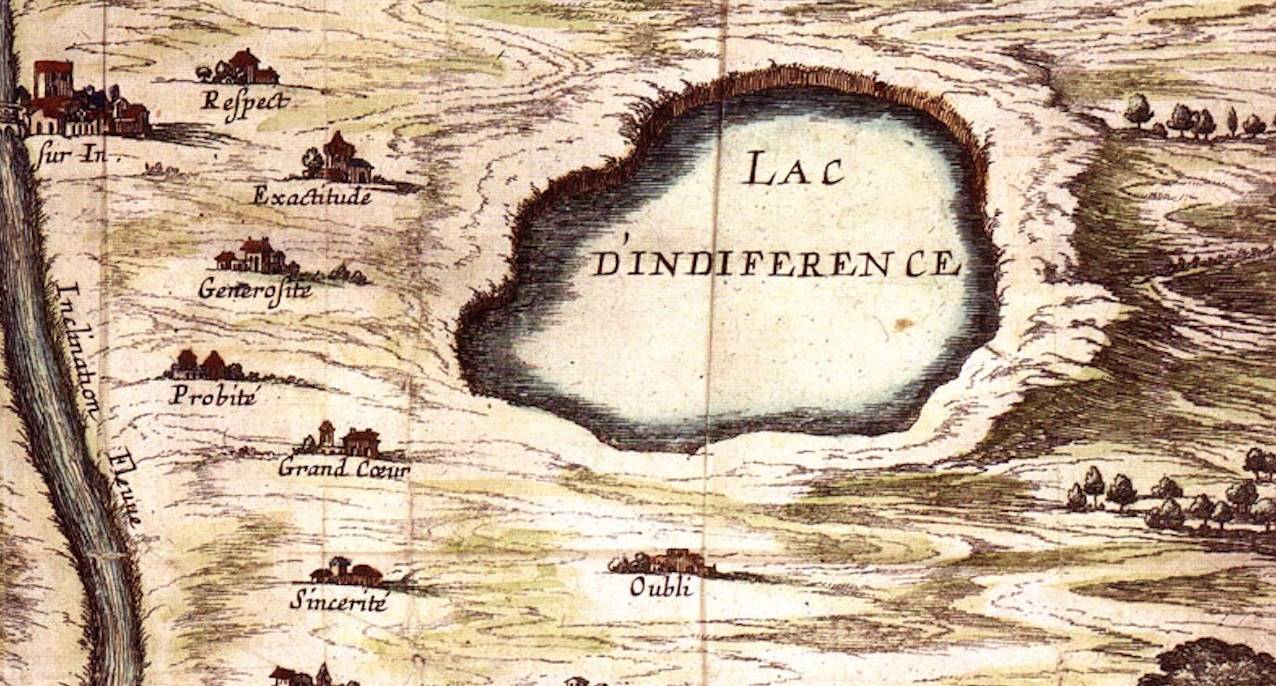An Antique Map Illustrates the Territory and the Adventure of Falling in Love
Created in the 17th century, the Carte Tendre maps the landscape and winding paths of love.
Of all the metaphors used to describe the processes of love, perhaps those relating to geography, especially to bodies of water, are the most accurate and poetic. Think of rivers that flow into the sea. La Carte de Tendre, made in the 17th century, is undoubtedly one of the most beautiful and accurate analogies, as it illustrates the sinuous paths of romantic love with an all-enveloping and feminine fidelity.
Drawn by several hands between 1653 and 1654, La Carte de Tendre is known to have been made by the Marquise de Rambouillet, Catherine de Vivonne – a crucial figure in the French literature of the time – and by Madeleine de Scudéry, a writer who included the beautiful map in her novel, Clélie.
The plan, which could also function as an instruction manual, illustrates a fictional country called Tendre. It’s an idyllic pastoral land of mountains, rivers, and lakes, and which metaphorically emulates the process of love, its stages, and its traps. Every journey through the country of romance begins in a place called Nouvelle Amité (New Friendship). The traveler is then presented with three possible routes ( that is if he doesn’t fall into the “Lake of Indifference” or the “Sea of Enmity”). The Tendre-sur-Inclination is a path of mutual inclination, the fastest and least scaled route. The Tendre-sur-Reconnaissance (recognition) or the Tendre-sur-Estime (esteem) are two routes which include stops at the small villages graciously illustrated on the map.
The villages along the routes of love have also been named suggestively: Generosité (Generosity), Billet Doux (Love Letter), Petis Soins (Little Gifts). If the traveler takes the wrong route, it’s quite possible he’ll arrive in Probité (Forbidden), Oubli (Forgotten) Perfidie (Duplicity) or in Indiscretion. The passion along this loving route is located near the edges of the map, near La Mer Dangereuse (The Dangerous Sea), and with all that this thus implies.
Later feminist readings of La Carte de Tendre recognize the strong political implications in the document, although in the most philosophical sense of the word. This romantic route, full of dangers and pitfalls, re-discovers the importance of the female prerogative in the process of courtship and the triumph of a loving relationship.
With any reading of this map – as a beautiful geography of loving feelings and as a witness to the deeper conventions of its time – it’s undeniable that it channels clues, even allegorically, about infatuation that remain with us even today. In short, we’re reminded that both the complex and the timeless are still two qualities of romantic love.

Related Articles
Pictorial spiritism (a woman's drawings guided by a spirit)
There are numerous examples in the history of self-taught artists which suggest an interrogation of that which we take for granted within the universe of art. Such was the case with figures like
Astounding fairytale illustrations from Japan
Fairy tales tribal stories— are more than childish tales. Such fictions, the characters of which inhabit our earliest memories, aren’t just literary works with an aesthetic and pleasant purpose. They
A cinematic poem and an ode to water: its rhythms, shapes and textures
Here lies One Whose Name was writ in Water. - John Keats Without water the equation of life, at least life as we know it, would be impossible. A growing hypothesis holds that water, including the
Watch beauty unfold through science in this "ode to a flower" (video)
The study of the microscopic is one of the richest, most aesthetic methods of understanding the world. Lucky is the scientist who, upon seeing something beautiful, is able to see all of the tiny
To invent those we love or to see them as they are? Love in two of the movies' favorite scenes
So much has been said already, of “love” that it’s difficult to add anything, much less something new. It’s possible, though, perhaps because even if you try to pass through the sieve of all our
This app allows you to find and preserve ancient typographies
Most people, even those who are far removed from the world of design, are familiar with some type of typography and its ability to transform any text, help out dyslexics or stretch an eight page paper
The secrets of the mind-body connection
For decades medical research has recognized the existence of the placebo effect — in which the assumption that a medication will help produces actual physical improvements. In addition to this, a
The sea as infinite laboratory
Much of our thinking on the shape of the world and the universe derives from the way scientists and artists have approached these topics over time. Our fascination with the mysteries of the
Sharing and collaborating - natural movements of the creative being
We might sometimes think that artistic or creative activity is, in essence, individualistic. The Genesis of Judeo-Christian tradition portrays a God whose decision to create the world is as vehement
John Malkovich becomes David Lynch (and other characters)
John Malkovich and David Lynch are, respectively, the actor and film director who’ve implicitly or explicitly addressed the issues of identity and its porous barriers through numerous projects. Now










